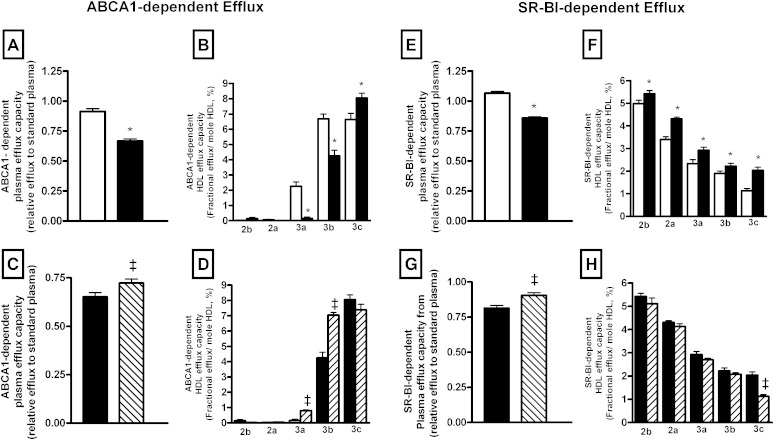Fig. 2.
A–D: Bar graphs showing ABCA1-dependent efflux capacity of plasma (A, C), or isolated HDL subspecies (B, D) determined in HIV-infected subjects (n = 231; closed bars) and HIV-uninfected controls (n = 200; open bars) (A, B) and in a subset of HIV-infected patients before (n = 41; closed bars) and after HAART (n = 41; hatched bars) (C, D). The ABCA1-dependent efflux was calculated as the difference between fractional cholesterol efflux to cells in the presence or absence of tetracycline after 4 h incubation in the presence of 40-fold-diluted plasma or isolated HDL particles. E–H: Bar graphs showing SR-BI-dependent efflux capacity of plasma (E, G) or isolated HDL subspecies (F, H) determined in HIV-infected subjects (n = 231; closed bars) and controls (n = 200; open bars) (E, F) and in a subset of HIV-infected patients before (n = 41; closed bars) and after HAART (n = 41; hatched bars) (G, H). The SR-BI-dependent cholesterol efflux was determined in cultured rat hepatoma Fu5AH cells expressing high levels of SR-BI. The capacity of HDL2 (2b and 2a) and HDL3 (3a, 3b, and 3c) subfractions to mediate FC efflux through the ABCA1 (B, C) and SR-BI (F, H) pathways and expressed per moles of HDL particles. Values are mean ± SEM. *P < 0.05 versus controls; ‡P < 0.05 versus HIV-infected patients before treatment.

